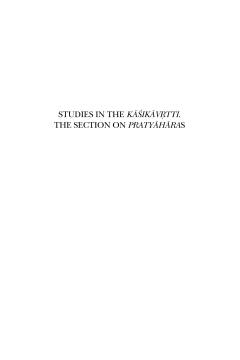
Additional Information
Book Details
Abstract
The volume is the first outcome of an international project aiming to create a complete critical edition of the ‘Kasikavrtti’ (7th c. CE) of Jayaditya and Vamana, the oldest surviving complete commentary on the ‘Astadhyayi of Panini’ (ca. 4th c. BCE). The first phase, culminating in this critical edition of the Kasika’s initial section (devoted to the ‘Pratyaharasutras’, the ‘rules for abbreviations’) was jointly coordinated by the editors together with Professor Saroja Bhate, a Paninian scholar of global renown. This edition is accompanied by a description of the manuscripts collated, an annotated English translation by the editors, and a series of editorial contributions dealing with the history of the Kasikavrtti’s editions and its current textual sources. Summaries of the methodology and results of the project’s first phase are also included. In the second part of the study, various authors discuss an array of theoretical, historical and methodological topics ranging from the historical importance of the Kasika and its relation with the seminal ‘Mahabhasya’ of Patanjali, to a comparison with the corresponding section in the ‘Candravrtti’, the evidence of Bhartrhari’s influence on the Kasika, and the copyists’ invocations and the incipit attested in the ‘Kasikavrtti’ manuscripts.
The volume is the first outcome of an international project aiming towards a complete critical edition of the Kasikavrtti (7th c. CE) of Jayaditya and Vamana, the oldest surviving complete commentary on the Astadhyayi of Panini (ca. 4th c. BCE). The first phase, culminating in the critical edition of the Kasika’s initial section devoted to the Pratyaharasutras, the ‘rules for abbreviations’, was jointly coordinated by the editors together with Professor Saroja Bhate (Pune), a Paninian scholar of global renown. The first part of the volume presents the critical edition of the Pratyaharasutra section by Bhate, Haag and Vergiani, along with a description of the manuscripts collated, an annotated English translation by the editors, and the editors’ contributions dealing with the history of the Kasikavrtti’s editions and the currently available textual sources, as well as the methodology and results of the first phase of the project. In the second part, various authors discuss theoretical, historical and methodological topics ranging from the historical importance of the Kasika and its relation with the seminal Mahabhasya of Patanjali, to a comparison with the corresponding section in the Candavrtti, the evidence of Bhartrhari’s influence on the Kasika, and the copyists’ invocations and the incipit attested in the Kasikavrtti manuscripts.
Pascale Haag is an assistant professor at the École des Hautes Études en Sciences Sociales (School for Advanced Studies in the Social Sciences) in Paris, France, and a member of the Centre d’Études de l’Inde et de l’Asie du Sud (CEIAS-UMR 8564).
Vincenzo Vergiani is a lecturer in Sanskrit at the Faculty of Asian and Middle Eastern Studies, University of Cambridge.
Table of Contents
| Section Title | Page | Action | Price |
|---|---|---|---|
| FRONT MATTER | 1 | ||
| Half Title Page | 1 | ||
| Series Page | 2 | ||
| Full Title Page | 3 | ||
| Copyright Page | 4 | ||
| Dedication | 5 | ||
| Contents | 7 | ||
| Acknowledgements | 9 | ||
| Abbreviations | 13 | ||
| Preface | 15 | ||
| MAIN MATTER | 19 | ||
| I. INTRODUCTION | 19 | ||
| PASCALE HAAG - Introduction | 21 | ||
| VINCENZO VERGIANI - Methodology and Research | 31 | ||
| SAROJA BHATE, PASCALE HAAG, VINCENZO VERGIANI - Description of Manuscripts | 53 | ||
| II. CRITICAL EDITION AND TRANSLATION | 75 | ||
| SAROJA BHATE, PASCALE HAAG, VINCENZO VERGIANI - Critical Edition | 77 | ||
| PASCALE HAAG, VINCENZO VERGIANI - Translation: The Section on Abbreviations | 101 | ||
| Appendix to the Translation | 119 | ||
| III. ESSAYS | 127 | ||
| JOHANNES BRONKHORST - The Importance of the ‘Kasika’ | 129 | ||
| SAROJA BHATE - The ‘Mahabhasya’ and the ‘Kasikavrtti’. A Case Study | 141 | ||
| S.L.P. ANJANEYA SARMA - ‘astadhyayyam prathamadhyayasthamahabhasyakasikavrttyoh ka cana samiksa’ | 153 | ||
| VINCENZO VERGIANI - A Quotation of the ‘Mahabhasyadipika’ of Bhartrhari in the ‘Pratyahara’ Section of the ‘Kasikavrtti’ | 161 | ||
| EMILIE AUSSANT - ‘Kasikavrtti’ and ‘Candravyakarana’: A Comparison of the ‘Pratyaharasutra’ Section | 191 | ||
| PASCALE HAAG - Paratextual Elements in Indian Manuscripts: The Copyists’ Invocations and the Incipit of the ‘Kasikavrtti’ | 215 | ||
| VINCENZO VERGIANI - The Relationship between the Manuscripts | 243 | ||
| END MATTER | 263 | ||
| PASCALE HAAG - Bibliography on the ‘Kasikavrtti’ | 263 |
